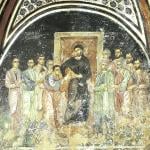Early Christian writers were able to see the work of providence in the gentile nations. While pagans were outside of the covenant of God with Israel, this did not mean they were outside of God’s providence. For Christ to be the expectation of the nations, God had to prepare them for the Gospel. Thus, there was considerable interest in seeing how this preparation was done, with Eusebius’s Preparation for the Gospel being one of the most profound representations of this search. Recognizing the work of God with the pagans, recognizing holy pagans, did not mean everything the pagans believed or taught was to be accepted, but on the other hand, being outside of the covenant of Israel did not mean they had nothing to contribute for the Church. Indeed, it was understood that there were holy pagans, some whose nobility of mind and spirit represented a “pre-Christian” Christianity:
We have been taught that Christ is the first-born of God, and we have declared above that He is the Word of whom every race of men were partakers; and those who lived reasonably are Christians, even though they have been thought atheists; as, among the Greeks, Socrates and Heraclitus, and men like them; and among the barbarians, Abraham, and Ananias, and Azarias, and Misael, and Elias, and many others whose actions and names we now decline to recount, because we know it would be tedious. [1]
Pagan philosophers were religious, and in the ancient world, philosophy and theology were not distinguished as it was today. Plato, with his Platonic tradition, formulated a pagan tradition (and the same could be said of Aristotle). Early Christians saw Platonists as rivals – indeed, it was through Platonism that Julian the Apostate turned back toward paganism, for it offered an apologetic for pagan traditions. Yet, they also saw there was truth contained in philosophy, truth which Christians could not dismiss, despite its non-Christian source. Christians adopted philosophy (to varying degrees) as they engaged theological debates; this would be the source of the notion that philosophy is the handmaid of theology. We must not forget that many criticized the used of philosophy because of its pagan source, and even saints were condemned by critics as abandoning the Christian faith because of their embrace of pagan philosophy (and this didn’t just happen in the patristic era, we can see the sharp criticism scholasticism faced because of its use of Aristotle). Origen, however, suggested that Christians can look to philosophy as something to take from similar to how Israel took spoils from Egypt:
But I would wish you to employ the full power of your pursuit ultimately for Christianity; therefore as a means I would beseech you to extract from the philosophy of the Greeks all those general lessons and instructions which can serve Christianity, and whatever from geometry and astronomy will be useful for interpreting the holy Scripture. […]
And precisely this point is hinted at by the passage in Exodus written from the person of God, when the children of Israel are told to ask their neighbors and acquaintances for gold and silver vessels and for clothing, so that having despoiled the Egyptians they might find material to fashion from what the acquired for the worship of God.[2]
Just as Israel took gold and silver even from the idols of Egypt and used it to create ritual items of their own, so too Christian can take the materials of pre-Christian traditions and transform them for Christian use.
However, as Sergius Bulgakov notes, this pre-Christian anticipation is not limited to philosophy. The arts of the ancients also helped predispose the ancient world, giving as it were a theology of icons necessary for the Christian faith:
Just as in its highest achievements Greek philosophy manifested itself as a Christianity before Christ, and on this basis also became the natural language of Christian revelation and theology, so the revelation of the art of antiquity in the form of iconography was, in a certain though limited sense, a Christianity before Christ and indisputably served as the prototype of the Christian icon. The pagan, and especially the Greek, world manifested man’s likeness to God, representing his likeness in ideal images of natural man as the perfect form of corporeality. And these manifestations of beauty were so convincing and irresistible that, after them, there was no need to find or present anew the possibility of the icon.[3]
What was already known through pagan art became the principle foundation for Christian art, though of course it needed to be transformed through the cross. As with pagan philosophy, there was a need for baptism, a transformation to take what was good and true in pagan art and elevate it, removing from it the imperfect or even demonic attachments which could be found connected to it:
Pagan art needed to be exorcised, and this exorcism was performed by Christianity. As a direct result of this exorcism, art as such suffered a loss, but in return it stopped being possessed. For Christian theology pagan iconography already posed the general question concerning the nature of icons of the Deity and whether they are possible, as well as concerning the pathways of art as a special form of the knowledge of God.[4]
When we begin to see how pagan ritual art could be transformed for Christian use, and when we understand that pagan philosophy was fundamentally religious with religious beliefs which were not always in accord with the Christian faith, we can begin to understand greater our approach to other non-Christian religious traditions so as to see what they offer us through the preparation for the Gospel contained within them. This preparation gave them something of value, something possibly unique which has a place within the Christian faith just as ancient artistic forms could be contained within Christian art. Should we not be surprised, therefore, that people look to India, for its traditions, to see what can be found within that can help Christians in their daily life? Yoga, for example, is an ancient meditative practice, a practice which does not have to be associated with Hindu gods (as Buddhist Yogic traditions present) and yet it is a practice with techniques and methods which, much like Greek art, anticipates Christian mysticism (and even forms of Christian meditation). Just as a Christian can embrace Greek philosophy and consider themselves a Platonist or an Aristotelian, just as a Christian can embrace the artistic forms established by pagan ritual art and use it for Christian veneration in icons and statues, so a Christian can embrace a transformed Yogic practice and realize it holds another anticipation of the Gospel for the Christian to explore. Of course, there is the need to do so as a Christian. Just as a Christian Platonist needs to engage Platonism as a Christian, so those who explore Yoga, learn from it, should be able to take what they learn and bring it in union with the practices and teachings of the Christian faith. It requires the realization of one’s union with Christ (like the Song of Songs) is a matter of synergy, where Christ’s work is the foundation for the possibility of such a union (making it not a Pelagian endeavor).
We do sense of the possibility of this found even in patristic literature: though not as much was known or studied from Indian sources, the little which was known was commented upon, sometimes negatively (as with other non-Christian material), but sometimes with a more positive acceptance of what was said. St. Jerome could use legends of the Buddha in defense of the honor of virginity.[5] But more interesting is the work attributed to Palladius, defender and biographer of St John Chrysostom, and famed chronicler of monks, is “On the Life of the Brahmans.” In it, the author writes upon what he heard about the life of ascetics in India, coming to praise their struggles; most of it is a supposed examination conducted by Alexander the Great on their way of life, being exhorted to join them in their holy pursuits. We hear, moreover, a sense of providence associated with them, for Palladius explains how he was told that they were:
…a race set apart, not by choice, but by the dispensation of God above, who has appointed them to live according to nature, in nakedness, on the banks of the river. […] They reverence God and have some slight knowledge of him, and although they are unable to analyze the ways of Providence in a sophisticated manner, they nevertheless pray unceasingly.[6]
It should not be surprising that one attracted to asceticism and mystical prayer should be attracted to Indian ascetics and to recognize providence as being behind their way of life. What is interesting, however, is how their meditation is explained as unceasing prayer – the hallmark of the Christian East. We see, therefore, in the ancient Christian world, already a hint of the idea that India contains the pre-Christian representation of Christian mediation.
When we explore important hesychast texts, we can see the way the ancient Indian tradition presupposes Christian meditation. Eastern meditation is famous for its grasp of the body, as seeing the body and how one sits, how one breaths requires proper form in order to have the best meditative experience. Hesychasm, with its prayer of Jesus, offers the same – one breaths in and out saying the name of Jesus. “Seat yourself, then, concentrate your intellect, and lead it into the respiratory passage through which your breath passes into your heart. Put pressure on your intellect and compel it to descent with your inhaled breath into your heart. Once it enters there, what follows will neither be dismal nor glum.”[7] One is to engage watchful awareness. There is an emptying of oneself of all that is not Christ, of all the passions so that one can center upon Christ himself:
Restrain your breathing, so as not to breathe unimpededly; for when you exhale, the air, rising form the heart beclouds the intellect and ruffles your thinking, keeping the intellect away from the heart. The intellect is either enslaved by forgetfulness or induced to give its attention to all manner of things, insensibly becoming preoccupied with what it should ignore. If you see impure evil thoughts rising up and assuming various forms in your intellect, do not be started. Even if images of good things appear to you, pay no attention to them. But restraining your breathing as much as possible and enclosing your intellect in your heart, invoke the Lord Jesus continuously and diligently and you will swiftly consume and subdue them.[8]
The body is not to be rejected, but is to be properly guided. We are called to such meditation so that we can be enlightened by Christ’s grace. This is indeed the proper fruit of such meditative practice: “It is then that the intellect is illumined by the divine Logos who enables it to perceive clearly the inner essences – the logoi – of created things and on account of its purity reveals to it the mysteries of nature.”[9] Through cleansing of the mind through watchfulness, through diligent, constant meditation, the hesychast finds union with God, participating in the uncreated energies of God, the radiant light of Tabor.
Now, some might say, if we have Christian meditation, is there any need for the exploration of Indian traditions, even if we accept their anticipatory status? The answer, of course, is no; there is no need, but this does not mean there is no good to be had if one does so. Just as not everyone has to follow St Thomas Aquinas in the exploration of Aristotle so not everyone needs to follow those who would engage Indian religious traditions. However, just as there was good done by St Thomas, so there can be good in such an exploration: there is a wealth of knowledge and wisdom to be had. There are aspects of the human condition to explore, to get to know, to appreciate. By exploring the mystical traditions of India, we can come to better understand what it means to die to the self and live in Christ; we can better understand how we are to follow Christ in self-emptying in order to experience the glory of the kingdom of God. We can see better what synergy means for the Christian life, how we must work and yet realize the limitations of that work, to see how grace flows in once we open ourselves up to it, to make us truly temples of the Holy Spirit. We do not have to fear India, we need to baptize it, to take it in, just as we took on the Hellenistic world. Just as grace perfects nature and does not destroy it, so does grace perfect the human experience and affirms it while straightening it out, making something new and exciting when it touches a new aspect of the human condition. It is to God’s glory, not the devil’s, that Christians study and engage the traditions of India, for to do so is to recognize providence and grace, to recognize the fundamental goodness of the world (despite the evil phenomena which covers it up). And is that not also a lesson we learn from India – that the world as it appears is not the world as it is, but a world covered in illusion which we must get beyond to see the fundamental good which lies beneath such phenomenal appearances?
[1] St Justin Martyr, “First Apology” in ANF(1):178.
[2] Origen, “Letter of Origen to Gregory” in St. Gregory Thaumaturgus: Life and Works. trans. Michael Slusser (Washington, DC: CUA Press, 1998), 190.
[3] Sergius Bulgakov. Icons and the Name of God. trans. Boris Jakim (Grand Rapids, MI: William B. Eerdman’s Publishing Company, 2012), 4.
[4] Ibid., 5.
[5] Cf. Against Jovinianus I.42.
[6] Palladius, “On the Life of the Brahmans” in Legends of Alexander the Great. Trans. Richard Stoneman (London: Everyman, 1994), 37.
[7] St Nikiphoros the Monk, “On Watchfulness” in The Philokalia. Vol. 4. trans. G.E.H. Palmer, Philip Sherrard and Kallistos Ware (London: Faber and Faber, 1995), 205.
[8] St Gregory of Sinai, “On Stillness” in The Philokalia. Vol. 4. trans. G.E.H. Palmer, Philip Sherrard and Kallistos Ware (London: Faber and Faber, 1995), 264.
[9] St Gregory Palamas, “To the Most Reverend Nun Xenia” in The Philokalia. Vol. 4. trans. G.E.H. Palmer, Philip Sherrard and Kallistos Ware (London: Faber and Faber, 1995), 318.
















